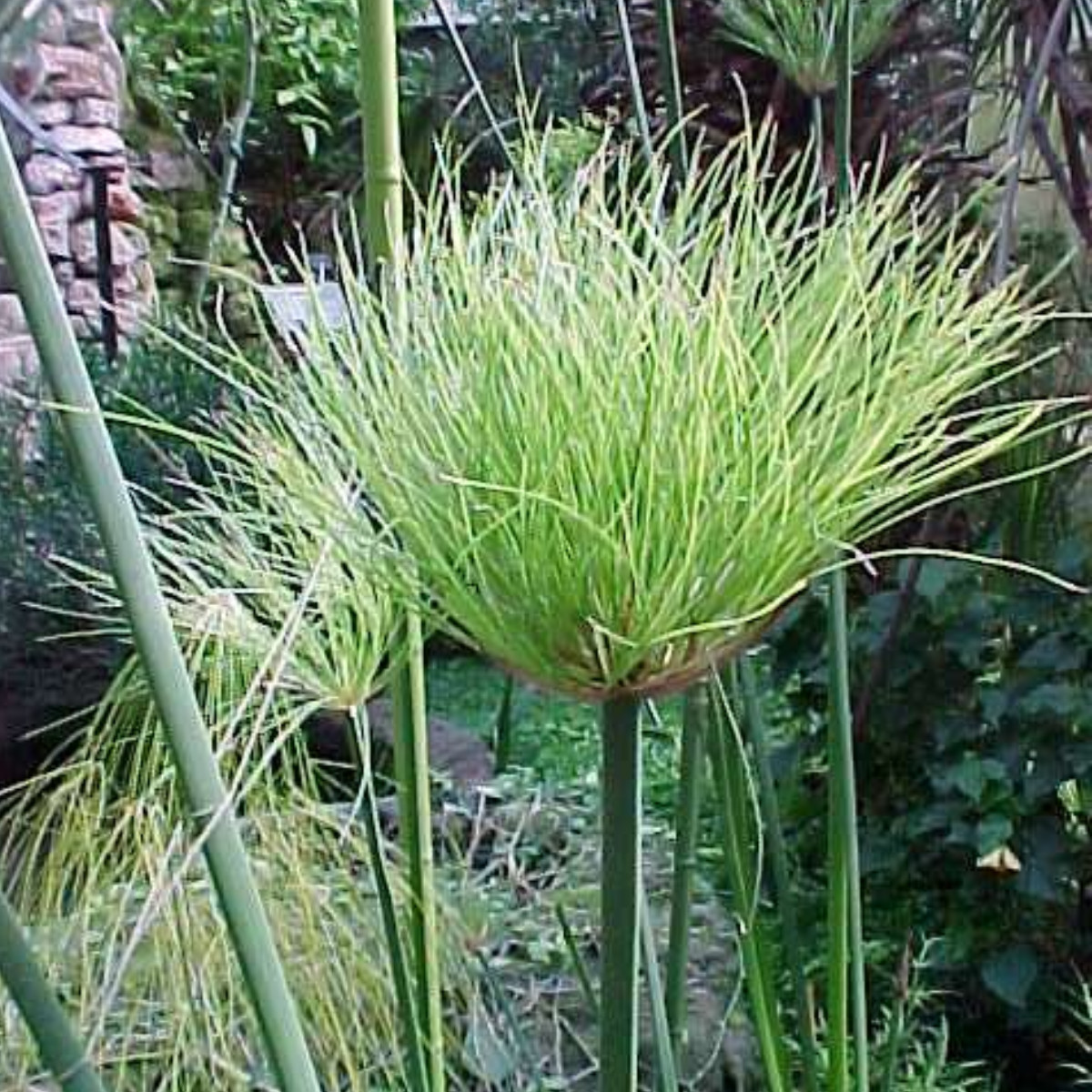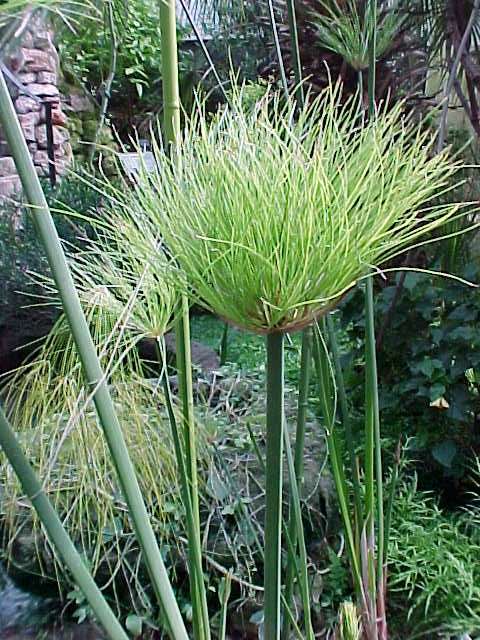Family: Cyperaceae
Synonyms: Chlorocyperus papyrus Rikli
Cyperus domesticus Poir.
Cyperus papyraceus Crantz
Cyperus papyrus L. subspecies antiquorum (Willd.) Chiov.
Cyperus syriacus Parl.
Papyrus antiquorum Willd.
Common Names: Papyrus, Papyrus Sedge, Egyptian Paper Reed. Giant Papyrus
Distribution & Habitat: Cyperus papyrus is distributed in northern and central Africa and Sri Lanka. It is native in the following countries: Benin; Botswana; Burundi; Cameroon; Congo; Egypt; Ethiopia; Gabon; India (Gujarat, Rajasthan); Indonesia; Israel; Madagascar; Malawi; Nigeria; Rwanda; Sri Lanka; Syrian Arab Republic; Taiwan, Province of China; Tanzania, United Republic of; Uganda; Zambia.
It is a perennial herb, rooted in lakes, along rivers forming floating mats or islands.
Description: This tall, robust, leafless aquatic plant can grow 4 to 5 m (13 to 16 ft) high. It forms a grass-like clump of triangular green stems that rise up from thick, woody rhizomes. Each stem is topped by a dense cluster of thin, bright green, thread-like stems around 10 to 30 cm (4 to 10 in) in length, resembling a feather duster when the plant is young. Greenish-brown flower clusters eventually appear at the ends of the rays, giving way to brown, nut-like fruits.
The younger parts of the rhizome are covered by red-brown, papery, triangular scales, which also cover the base of the culms. Botanically these represent reduced leaves, so strictly it is not quite correct to call this plant fully "leafless".
In its natural habitat Cyperus papyrus occurs in large, dense populations, often lining bodies of water such as in the Okavango Swamps of Botswana. Interestingly, in the Okavango at least, the plants have been observed to colonize the channels that are cleared by hippopotamus through the dense swamp vegetation. In turn, the 'feather-duster' flowering heads of papyrus make ideal nesting sites for many social species of birds. As in most sedges, pollination is effected by wind, not insects, and the mature fruits after release are distributed by wind and water.
Proper Care:
While papyrus is a perennial, good for zones 9-11, it can tolerate zone 8 with proper care. Grown outside of those areas, it needs to be treated like an annual or half-hardy perennial. It is sensitive to cold temperatures and frost, but can be brought indoors and grown easily in the winter.
An unbelievably fast grower, small plants in spring. One requirement for optimum growth is a full sun exposure, which keeps the tall stems stiff and rigid.
Light: They need full sun but also need to be sheltered from strong winds t0 maintain its foll and lush appearance, and for best effect should be allowed to form a large colony.
Temperature: Papyrus ranges from subtropical to tropical desert to wet forests, tolerating annual temperatures of 20 C (68F) to 30 C (86F) and a pH of 6.0 to 8.5.
Watering: Very high moisture needs; suitable for bogs and water gardens
Feeding: Feed monthly spring through fall with a balanced liquid fertilizer diluted by half. Only fertilize when watering to avoid fertilizer burn.
Potting and repotting: Divide the root ball of container-grown papyrus plants. Re-pot or dispose of the divisions. Dividing the root ball makes the plant more vigorous.
Cut the plant back in the autumn when the culms begin to turn yellow and die. Dig out the roots of the plant and brush off the excess soil. The Cyperus papyrus grows in a clump of rhizomes, and the root ball should be fairly contained.
Pull the pot out of the water if the plant was grown in a water garden and allow it to drain. After it drains, remove the plant from the basket. Trim the roots of the papyrus. Cut out any rhizomes that have discolored or rotted. This is a good time to divide the plant if necessary and treat the two halves as individual plants. Use a handsaw to cut the rhizomes in half.
It will grow well in any good potting mix. Pot in rich soil in a 75l (20-gallon) or larger container.
Propagation: Propagation is bydividing rhizomes, tubers, corms or bulbs (including offsets) in spring or autumn. Germination from seed is not recommended. The time period from seed to flowering is not known but it is undoubtedly several years.
From seed: stratify if sowing indoors. Allow seedheads to dry on plants; remove and collect seeds.
Papyrus plants that are growing outside year round will self-seed, if conditions are right. Pollination occurs with the help of the wind. However, the plant is easy to propagate by dividing the rhizomes whenever the clumps become too large. Discard the center stems, which tend to die with age. Propagation is usually done in the spring. New plants form in the wild when one of the curving stems develops a kink and the top of the plant becomes covered with water.
Usage: Rain Garden, Water Plant
Tall, graceful accent for water gardens, bogs or pond/stream peripheries. Patio containers/tubs. This plant is suitable for growing indoors. It makes for an unusual tropical accent and can even be used as a cut flower for arrangements.
Problems: No pests have been observed to attack Cyperus papyrus, with the exception of a rust fungus which appears to be specific to the family.
Comments: Because of the size of this specimen, it may be best grown in its own watertight container with water kept over the soil. Set the container on wheels to allow mobility of lhe plant, especially in zones colder than Zone 10.
Summary: Grow in wet, boggy soils in full sun to part shade. Best in part shade. Grow in containers at the margins of water gardens, pools or ponds. Grows well in both standing water (up to 12) and in boggy soils.
Cyperus Papyrus is not hardy enough to survive winters with freezing temperatures. It is a very fast grower and will quickly grow to impressive size when replanted in the spring.
CHARACTERISTICS:
Foliage green
Shape rossette
PROPER CARE:
Watering in rest period - plentifully
Watering in active growth period - plentifully
Light: Full sun to part shade
Temperature in rest period min 4C max 10C
Temperature in active growth period min 20C max 30C
Humidity high
Climate zone: 9-11
Begonia propagation f...
Essential Nutrients f...
Portulacaria afra
Tillandsia recurvata
Tillandsia stricta
Columnea microphylla
Clivia miniata
Cleyera japonica
Clerodendrum thomsoni...
Cleistocactus strausi...



